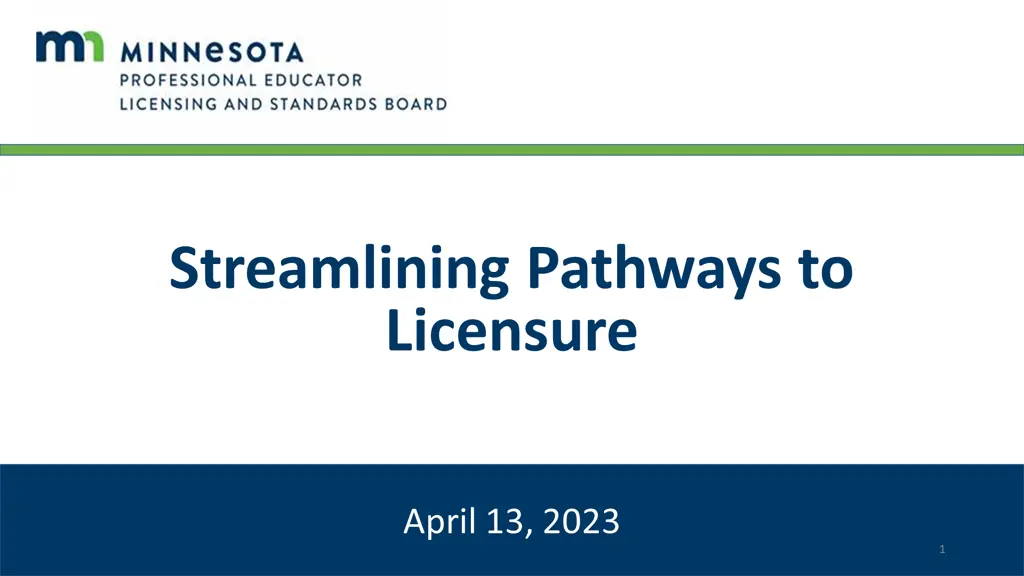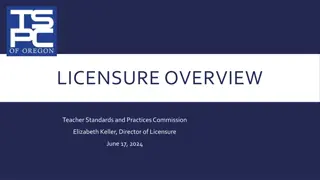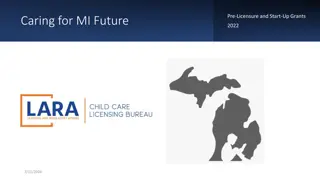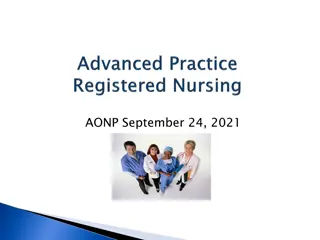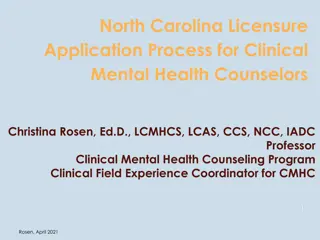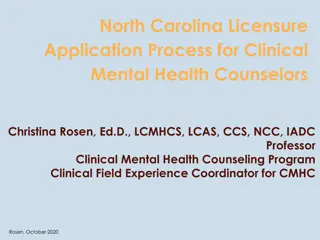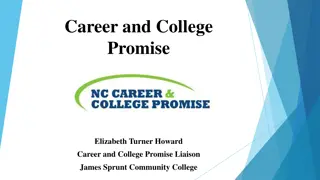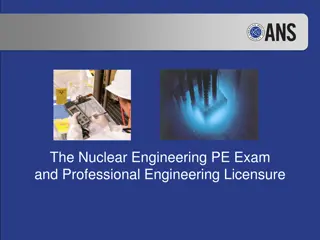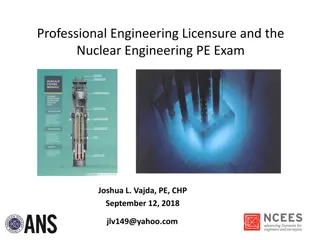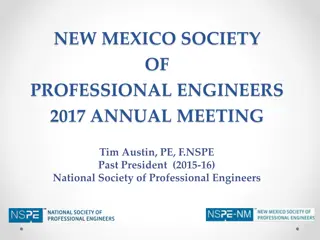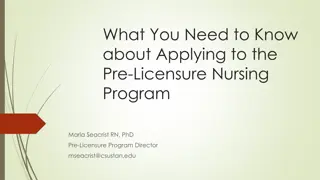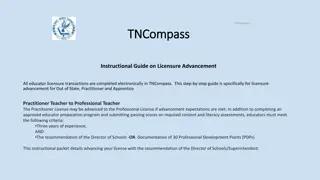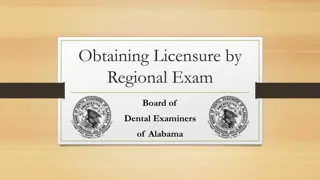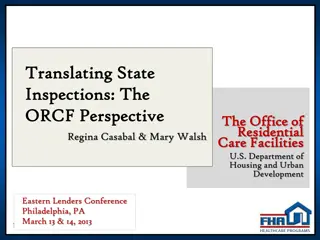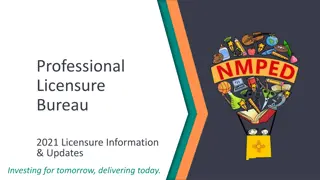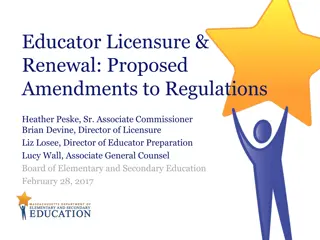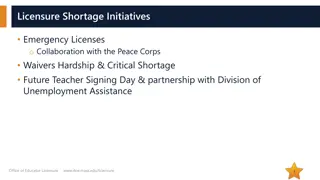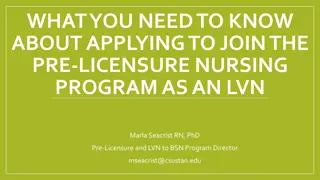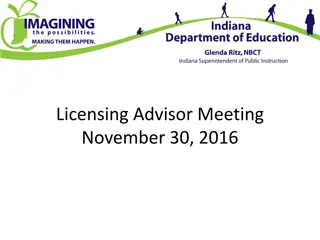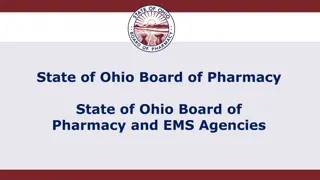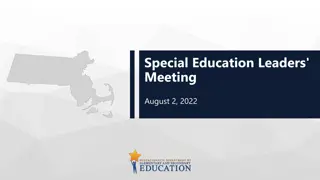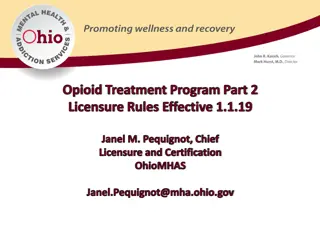Streamlining Pathways to Licensure
Learn about the prestigious National Board Certification, its rigorous process, eligibility criteria, benefits, and states' support. Discover how it can enhance your teaching career and professional development journey.
- Teacher Certification
- National Board
- Professional Development
- Teaching License
- Educational Excellence
Download Presentation

Please find below an Image/Link to download the presentation.
The content on the website is provided AS IS for your information and personal use only. It may not be sold, licensed, or shared on other websites without obtaining consent from the author. Download presentation by click this link. If you encounter any issues during the download, it is possible that the publisher has removed the file from their server.
E N D
Presentation Transcript
Streamlining Pathways to Licensure April 13, 2023 1
National Board Certification Background Considered highest professional certification teachers can achieve Developed by teachers, for teachers more than 35 years ago Certification available in 25 certificate areas, including Special Ed and CTE To be eligible for certification process teachers must: Hold a bachelor's degree Hold a valid teaching license Taught for at least 3 years Certification is valid for 5 years and can be renewed through National Board Certification professional development
National Board Certification Process Rigorous process that spans multiple measures Teachers have 3 years to submit four components and another 2 years to meet any deficiencies to achieve certification Components Met Through Content Knowledge Exam (multiple choice and constructed responses) Differentiation Instruction Classroom based portfolio- student work and analysis Teaching Practice and Learning Environment Classroom based portfolio via video recordings Effective and Reflective Practitioner Portfolio
National Board Certification Other States' Support Over half of states provide assistance or reimbursement to teachers who seek National Board Certification Fees approximately $2000 for initial certification Support includes: Scholarships to pay certification fees Stipends for teachers after certification is awarded Salary increase (5-12%) More than 35 states allow National Board Certification to count for teachers to obtain highest license available Minnesota allows for credential to count towards clock hours for renewal
National Board Certification PELSB Considerations Legislative Changes Allow National Board Certification to count for Tier 4 license (even if obtained in new area) Provide reimbursement to teachers who obtain credential Support cohort training by NBCT to teachers going through the process Arizona provides good example
Adding a license (Science) Example: Teacher holds a Tier 4 General Science license and would like to add a Chemistry license. Required Standards Met or required 8710.4750, Subp. 3, items E and F (Science Pedagogy and Reading in the Content Areas) Met by General Science License. Partially Met by Initial License. Ways to demonstrate: (1) Major in Chemistry, (2) Masters degree in chemistry, (3) Advanced Chemistry Coursework, (4) Experience in Chemistry Lab 8710.4750, Subp. 4 (Advanced knowledge of chemistry and ability to apply its fundamental principles, laws, and concepts)
Adding a license (ASL) Example: Teacher holds a Tier 4 DHH license and would like to add a ASL license. Required Standards Met or required ASLTA Master Certification (many states recognize this certification for licensure) 8710.4950, Subp. 5 and 6
Adding a license (Heritage Language) Example: Teacher holds a Tier 4 ESL license and would like to add a World Language & Cultures: Somali license. Required Standards Met or required Standards of Effective Practice Met through initial licensure Required. Ways to demonstrate: (1) Minnesota bilingual seal, (2) interpreter license, (3) language exams, etc., (4) Transcript demonstrating degree with coursework in target language World Language & Cultures: language proficiency standards World Language & Cultures: understanding of language acquisition standards Met through initial licensure Met largely by virtue of life experiences being a member of the Somali community World Language & Cultures: knowledge of target culture Required. Ways to demonstrate: (1) Professional development, (2) coursework World Language and Cultures: general cultural knowledge World Language & Cultures: methods standards Met through initial licensure
Adding a license (Reading) Example: Teacher holds a Tier 4 Elementary license and would like to add a Reading license based on LETRS completion. Required Standards Met or required LETRS Check for Understanding, Bridge to Practice Activities and face to face trainer report, lesson plans, student work, student data, coaching observation, coaching action plans, Knowledge of Foundations of Reading Processes and Instruction* Ability to use wide range of instructional practices* Same as above Required. Ways to demonstrate: (1) Evidence of student assessment, (2) Evidence connecting student assessments to inform instruction/interventions, (3) Evidence of being able to communicate assessment results Use a variety of assessment tools and practices for reading instruction Create a literate environment Required. Professional Development as a career-long effort Initial License?
Applying for an initial CTE license Example: Teacher holds a Tier 2 Communications Technology Careers (CTE) license and would like to obtain an initial Tier 3 license. Required Standards Met or required Standards of Effective Practice Required Communications Technology Careers license- specific standards Met through Associate s Degree in related field (for example Interactive Design Video) Met 11 of 16 core skills are met by the teacher serving as a Tier 2 CTE teacher in a MDE- approved CTE program CTE Core Skills Required 5 outstanding core skills
Looking ahead Future Board Work: Change Type of Change National Board Certification as pathway to licensure Legislative Coordinate district evaluation with Standards of Effective Practice Legislative Licensure areas with overlapping scope/content updated together Rulemaking Update Guidance documents to clarify how standards have already been met. Staff
District Support for Tier 1 & 2 Teachers Seeking Licensure Via Portfolio
Existing District Structures Teacher Development & Evaluation (TD&E) Minnesota Statute 122A.41 requires public school districts to implement a teacher development and evaluation model aligned to the standards of effective teaching (i.e. the standards of effective practice). While this looks different in each district, the use of common standards represents and opportunity for districts to structure teacher mentorship and professional development in an intentional way. Additionally, the state TD&E model demonstrates what robust mentorship and professional development look like when combined with district evaluation practices.
Existing District Structures State Teacher Development & Evaluation Model (TD&E)
Existing District Structures State Teacher Development & Evaluation Model (TD&E)
Aligning District Practices to Support Tier 1 & 2 Teachers The state TDE model provides space for innovative practices that can be used by districts and educators to support Tier 2 educators working to obtain a Tier 3 license via portfolio. PELSB recommends this be done in a few key ways: 1. Identifying where and how district Standards of Effective Teaching (SETs) align to specific Standards of Effective Practice (SEPs); 2. Focusing on items in statute that help demonstrate pedagogical skills; and 3. Ensuring observations are conducted not only by administrators, but also by classroom teachers who hold a professional license. 4. Ensuring Tier 1 & Tier 2 educators are mentored and evaluated on evidence that can be used in the portfolio (lesson plans, assessments, etc.)
Aligning District Practices to Support Tier 1 & 2 Teachers Standards of Effective Practice Standard 1G Student Learning The teacher understands that each student's cognitive, linguistic, social, emotional, and physical development influences learning and makes instructional decisions that build on learners' strengths, needs, and cultural ways of knowing. Standard 2D Learning Environments The teacher fosters an environment that ensures student identities such as race/ethnicity, national origin, language, sex and gender, gender identity, sexual orientation, physical/developmental/emotional ability, socioeconomic class, and religious beliefs are historically and socially contextualized, affirmed, and incorporated into a learning environment where students are empowered to learn and contribute as their whole selves. Standard 3E - Assessment The teacher knows how and when to engage students in analyzing their own assessment results and setting goals for their own learning. SPPS TDE Understanding of Learners: Demonstrates an understanding of all learners and makes content accessible, relevant, and equitable. Regularly incorporates knowledge of learners language(s), backgrounds, cultures, interests, learning styles, and special needs in lessons. Learner Engagement: Consistently attempts/strives to authentically and cognitively engage each learner in appropriate/relevant content. Consistently utilizes engagement/re-engagement strategies that are culturally responsive (ethnic, gender, orientation, socioeconomic, national, age, religion). Supplemental Evidence Examples of assignments that have been adjusted to respond to students knowledge and backgrounds Peer observations Examples of classroom practices (e.g. community guidelines) Examples of assignments that incorporate student identities into learning activities Peer observations Student Assessment for Learning: Regularly provides students with opportunities to reflect on and assess their own learning related to the assessment criteria (e.g. rubrics, charts, lists, exemplars). Rubrics Examples of student reflections
Aligning District Practices to Support Tier 1 & 2 Teachers Standards of Effective Practice Standard 4C Planning for Instruction The teacher creates or adapts lessons, unit plans, learning experiences, and aligned assessments based on Minnesota s academic standards, or if unavailable, local, national, or international discipline-specific standards. Standard 5J Instructional Strategies The teacher uses technology to create, adapt, and personalize learning experiences that foster independent learning and accommodate learner differences and needs. Standard 6G Professional Responsibilities The teacher uses a variety of self-assessment and problem- solving strategies to analyze and reflect on their practice and to make adaptations and adjustments toward more equitable outcomes. Standard 7A Collaboration & Leadership The teacher understands the importance of engaging in culturally affirming, reciprocal communication with families about student development, learning, and performance. SPPS TDE Standards Based Instruction: Standards-based instruction consistently moves learners into growth and mastery. Students are regularly involved in authentic learning activities. Supplemental Evidence Examples of assignments and/or lesson plans where state academic standards are addressed. Examples should reflect how students demonstrate standards. Technology Integration: Regularly uses available technology to support learning and fosters creativity, communication, collaboration, and/or critical thinking. Reflective Practices & Feedback: Regularly uses data and feedback to self-assess strengths and identify areas of growth. Regularly articulates and implements changes based on self- reflection and data. Communication with Families: Regularly provides appropriate information to families/guardians about a student's social and academic learning, explanation of services, and/or opportunities for learning. Information is regularly conveyed in a timely, professional, linguistically, and culturally sensitive manner. Lesson plans and/or assignments that incorporate technology. Examples of how/when data has been used to improve curriculum development and/or instructional practice. Peer observations Examples of communications with families and how these are culturally affirming
Looking ahead Future Board Work: Work with MDE to align state models with the SEPs Clarify the statutory reference to SEPs Work with districts on creating the infrastructure to support movement up the tiers through mentorship and evaluation plans
Save the Date Upcoming Round Tables Indigenous Educators: Preparation and Pathways to Licensure May 18, at 4:30 p.m. 21
